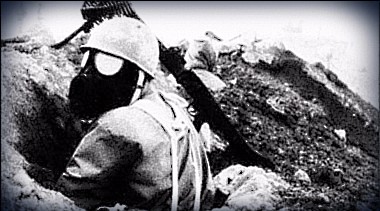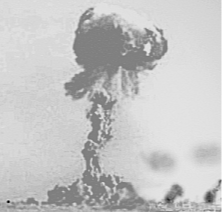December 7th, 1949
German and Finish forces link up east and north of Leningrad, completing the encirclement of the besieged city. However, the Soviets have stockpiled vast amounts of supplies and the 250,000 Soviet soldiers remaining inside the Leningrad pocket are well dug into both the city itself and the last ring of defensive belts around the city proper. The Germans, having suffered some 250,000 casualties in the massive effort to take the city since October, are content for the moment to consolidate their encirclement and begin to construct siege lines of their own to prevent the Soviets from breaking out or sneaking in men and supplies. German artillery and bombers hammer the city day and night as German armor and mechanized forces probe further east and north.
Soviet soldier in trenches outside Leningrad

German armor pushes East of Smolensk


In the center the Eastern front German forces pushing east from Smolensk and northeast from Orel link up just east of Tula and put that city under siege. Another German force striking east from the Kursk area reaches the river Don north and South of Voronezh but are forced to stop and consolidate their gains by overstretched lines of supply and determined resistance by Soviet forces.
To the south minor Axis forces occupy Voroshilovgrad and Rostov before stopping to allow their less mechanized infantry to come forward over the frozen terrain of southern Russia. Loyalist Soviet forces are in headlong retreat across southern Russia and the northern Caucasus towards the line of the rivers Don and Volga where Beria’s Soviet Union prepares to make a “final great stand against the fascist enemy” as radio Moscow puts it succinctly. With their reserves almost entirely depleted, and the Red Airforce able to mount only intermittent sorties, the Soviet Union force drafts hundreds of thousands of civilians to help dig trenches and construct defensive works all along the eastern banks of the rivers Don and Volga. Beyond this forming line lies only the open plains of Russia.
Europe : December 7th 1949

December 8th, 1949
U.S. forces,hoping to flank the Axis forces massing around Sevilla, make a new amphibious landing in southern Spain near Malaga. Two divisions come ashore with only light resistance from Spanish units in the area and begin to fan out and consolidate the beachhead. In the western mediteranan Italian submarines and torpedo boats continue to harass U.S. naval forces but the weight of American firepower has forced the remaining bulk of the Italian navy to take shelter in the central Mediteranean under land-based air coverage.
In northeastern China the communist insurgency, supported from PLA bases inside communist Manchuria, continues to rage. However, nationalist Chinese forces supported by American arms and advisors have so far managed to contain the insurgency mostly to the countryside. Nationalist threats to invade Manchuria or bomb PLA bases across the border have so far amounted to rhetoric as the U.S. and Soviets apply pressure to both sides to prevent the situation from escalating.
December 10th, 1949
Prowling U.S. submarines and maritime aircraft have severely hampered Japanese lines of communication between the Home Islands and Korea as the U.S. continues to tighten its crippling blockade of Japan. On the Home Islands themselves massive conventional and chemical raids continue to hammer Japanese cities several times a week though it has now been some time since any atomic attacks on Japan.
On Okinawa, Taiwan, islands in the central Pacific, and even coastal China and the Philippines U.S. forces have been massing now for many months as the U.S. general staff continues to debate whether to simply maintain the blockade of Japan or to set a Spring invasion date. One thing is clear, nothing less an unconditional Japanese surrender will be contemplated.
December 12th, 1949
U.S. and British heavy bombers operating out of Iraq target Baku in the first atomic attack since operation “Tumble Down” hammered continental Europe in late November. The large raid involves over 300 B-31 bombers, several hundred long range prop escort fighters, and two dozen B-34’s approaching above and behind the main mass of bombers and escorts. Rising to meet them are over 200 Axis interceptors, mainly German jet fighters and Turkish prop fighters purchased from Germany or produced locally on license. In addition, clouds of radar-guided flak and swarms anti-aircraft missiles fill the sky.
Alliance losses are heavy with nearly fifty B-31’s, six B-34’s, and several dozen escort fighters lost to enemy action. Axis fighter losses are relatively light at only a couple dozen fighters downed. In the midst of the chaotic scene over Baku all four B-34’s carrying atomic bombs arrive on target and drop their bombs. Four atomic blasts in the 40 kiloton range rock the landscape and, thanks to careful placement of the four atomic strikes, effectively destroy the oil fields in their entirety. For all intents and purposes the bulk of the Baku oil fields have simply ceased to exist. The Axis have been dealt a very heavy blow.
December 13th, 1949
In southern Spain Axis forces have been forced to withdraw from Sevilla, pulling back into central Spain and to positions in the rugged terrain East of Malaga in the south. U.S. forces pushing out of Malaga have already linked up with U.S. divisions pushing East from Portugal to occupy a large swath of southwestern Spain.
As the alliance presses forward with their invasion of Iberia they have begun to advance into Algeria as well. Advance U.S. forces, scouting far ahead of the main columns pressing into Algeria, have reached Oran and clashed with light Italian and German screening elements west of the city while the Axis continue their destruction of the port facilities and their general withdrawal East towards Algiers.
U.S. bombers are hammering logistical hubs, air fields, and troop concentrations from Algiers to Tunis while British and American air power operating out of Egypt does the same in Libya. The Axis still have significant airpower in North Africa but the sheer weight of U.S. airpower is grinding down the numbers of Axis fighters in the theatre much faster than they can be replaced.
In Italy the Axis Joint Command for the Mediteranean theatre begins preparations for an organized evacuation of North Africa with reluctant approval from Hitler and Mussolini.
December 15th, 1949
In Syria the nationalist coup has consolidated power. Though proclaiming independence the new nationalist Syrian government has taken a radically pan-arab position, spoken favorably of the Axis and nationalist rebels in Egypt and elsewhere, and called on all colonial elements to leave the arab lands in the middle east. Worse, from the Alliance point of view, Turkish army forces and German advisors and older-model aircraft begin to appear in the newly independent country.
British forces have massed at the Palestinian/Syrian frontier but have thus far not directly intervened other than to allow fleeing Free French forces to join them inside Palestine. However, late this day the Alliance for Democracy issues an ultimatum to Damascus, demanding the restoration of the French Mandate in Syria and threatening war if this demand is not met.
December 16th, 1949
Across western Europe Germany has been busy repairing the airfields least damaged by allied atomic attacks though their efforts have been slowed by ongoing Alliance conventional and chemical bombing of the airfields themselves and of logistical hubs. German engineers, now quite experienced in such matters, have become extremely proficient at rapidly repairing air fields, rail lines, and the like. It is a constant game of attrition between Alliance bombing and German repair efforts.
December 17th, 1949
From a new missile test range in the former Eastern Poland a German two-stage A-6 rocket secretly lofts a small satellite into Earth orbit. The satellite broadcasts a simple series of tones and pings at set intervals for test purposes. Von Braun has finally realized his vision to usher in the space age...though only a few in the upper echelons of the German High Command and inner circle of the NAZI party are aware of this fact. British intelligence will become aware of the feat several weeks later thanks to an intelligence asset who overhears a conversation between two Luftwaffe officers. However, Alliance intelligence remains unaware of the full capabilities of the A-5 and A-6.
The A-6 rocket, part of a German program to develop “artificial Earth orbiting satellites” for military and civil applications, is a heavier and specially modified variant of the A-5 which itself is a road-mobile two-stage ballistic missile still under development by the Luftwaffe. The A-5, designed as a weapon to reach the United States, is to have a range of up to 8500 kilometers with a CEP of approximately 5 kilometers when it enters production sometime in early to mid 1950. Launching from western France or Spain the missile will be able to reach targets in the Eastern U.S. and can carry a single large 5000kg conventional or chemical warhead.
Though the missile development team is not aware of it, the missile specifications are such that Germany’s first-generation Mk1 implosion atomic bomb design can be fitted into the warhead.
A prototype A-5 undergoing early testing









